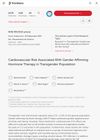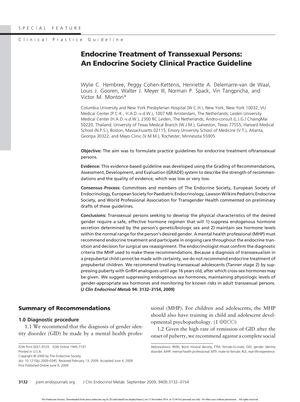TLDR The guideline recommends mental health involvement in diagnosing gender identity disorder and outlines hormone and surgical treatment protocols, emphasizing safety, informed consent, and long-term monitoring.
The 2009 Endocrine Society Clinical Practice Guideline provided comprehensive recommendations for the endocrine treatment of transsexual persons. It stressed the role of mental health professionals in diagnosing gender identity disorder (GID) and guiding treatment, which includes psychotherapy, real-life experience (RLE), hormone therapy, and surgical therapy. For prepubertal children, hormone treatment was not recommended due to high rates of GID remission after puberty. Adolescents could begin puberty suppression with GnRH analogues at Tanner stage 2 and cross-sex hormones at age 16, while adults required confirmed GID diagnosis and evaluation of medical conditions before starting hormone therapy. The guideline advised maintaining hormone levels within the normal range for the desired gender and monitoring for adverse outcomes, such as cardiovascular risk and bone density. It also highlighted the importance of informed consent, fertility counseling before treatment, and considering surgery only after consistent hormone treatment and RLE. The document underscored the need for long-term studies to assess the safety and effects of these treatments.
 57 citations
,
January 2004 in “Journal of Endocrinology”
57 citations
,
January 2004 in “Journal of Endocrinology” Baldness caused by male hormones in female-to-male transsexuals doesn't increase the risk of heart disease.
88 citations
,
September 2003 in “Clinical endocrinology” Hormone treatment for transsexual individuals is effective but carries risks like thromboembolic events and mood changes, with most side effects being minor and reversible.
164 citations
,
January 2003 in “Drugs”
 6 citations
,
April 2019 in “Endocrinology and Metabolism Clinics of North America”
6 citations
,
April 2019 in “Endocrinology and Metabolism Clinics of North America” Testosterone therapy for transmasculine individuals is generally safe with medical supervision, improves mental health, and has mixed effects on physical health.
 17 citations
,
February 2020 in “Journal of Pediatric and Adolescent Gynecology”
17 citations
,
February 2020 in “Journal of Pediatric and Adolescent Gynecology” Early medical support for transgender youth is important for their health, with low regret for gender-affirming hormone use and a need for knowledgeable care providers.
 15 citations
,
February 2019 in “Internal Medicine Journal”
15 citations
,
February 2019 in “Internal Medicine Journal” Australian doctors experienced in adult transgender healthcare mostly prescribe intramuscular testosterone and oral estradiol, recommend mental health assessments before hormone therapy, and support improved training and guidelines.
 51 citations
,
April 1999 in “The Journal of Steroid Biochemistry and Molecular Biology”
51 citations
,
April 1999 in “The Journal of Steroid Biochemistry and Molecular Biology” Testosterone replacement may improve sexual desire and bone health in women with low androgen levels, but more research is needed on its long-term safety.
 October 2023 in “Paediatrics & child health”
October 2023 in “Paediatrics & child health” The document advises health care providers on how to support transgender and gender-diverse youth with appropriate care and referrals.
 15 citations
,
September 2021 in “Frontiers in Endocrinology”
15 citations
,
September 2021 in “Frontiers in Endocrinology” Hormone therapy increases the risk of heart-related issues in transgender women and may affect heart health in transgender men.







